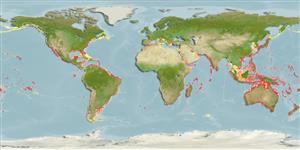Common names from other countries
Classification / Names / Names
Namen | Synonyme | Catalog of Fishes (gen., sp.) | ITIS | CoL | WoRMS
Environment: milieu / climate zone / depth range / distribution range
Ökologie
; tiefenbereich 0 - 50 m (Ref. 7727). Tropical
Circumglobal tropical, temperate seas and the Mediterranean Sea.
Length at first maturity / Size / Gewicht / Alter
Maturity: Lm ? range ? - ? cm Max length : 19.0 cm TL Männchen/unbestimmt; (Ref. 126605); max. veröff. Gewicht: 41.00 g (Ref. 126605); max. veröff. Alter: 1.00 Jahre (Ref. 126605)
Sea hares have annual life cycles (Ref. 126605). Found roaming around various species of algae. A nocturnal species (Ref. 822). Common in intertidal and subtidal habitats to about 5 m in depth. A specialized herbivore and feeds largely on red algae (Ref. 866). Known from depths of 0 to 50 m (Ref. 7727); and from intertidal rock pools, and immediate subtidal on alga-covered reefs (Ref. 337). Also on seagrass (Ref. 109264).
Life cycle and mating behavior
Geschlechtsreife | Fortpflanzung | Ablaichen | Eier | Fecundity | Larven
Members of the order Anaspidea are mostly simultaneous hermaphrodites.
Burn, R. 2006. (Ref. 7727)
IUCN Rote Liste Status (Ref. 130435)
CITES Status (Ref. 108899)
Not Evaluated
Not Evaluated
Nutzung durch Menschen
| FishSource |
Tools
Mehr Information
Alter/Größe
Wachstum
Länge-Gewicht
Länge-Länge
Morphologie
Larven
Dichte
Internet Quellen
Estimates based on models
Preferred temperature
(Ref.
115969): 15.3 - 28.8, mean 26.7 (based on 1728 cells).
Verwundbarkeit
Low vulnerability (10 of 100).
Preiskategorie
Unknown.
